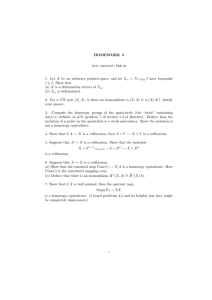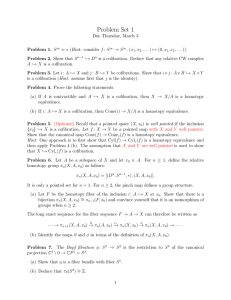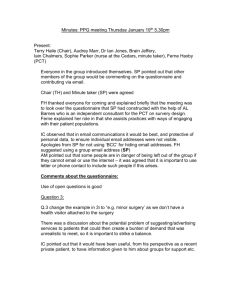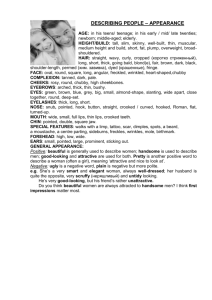LECTURE 3: POINTED SPACES AND ... 1. Pointed spaces Let Top
advertisement
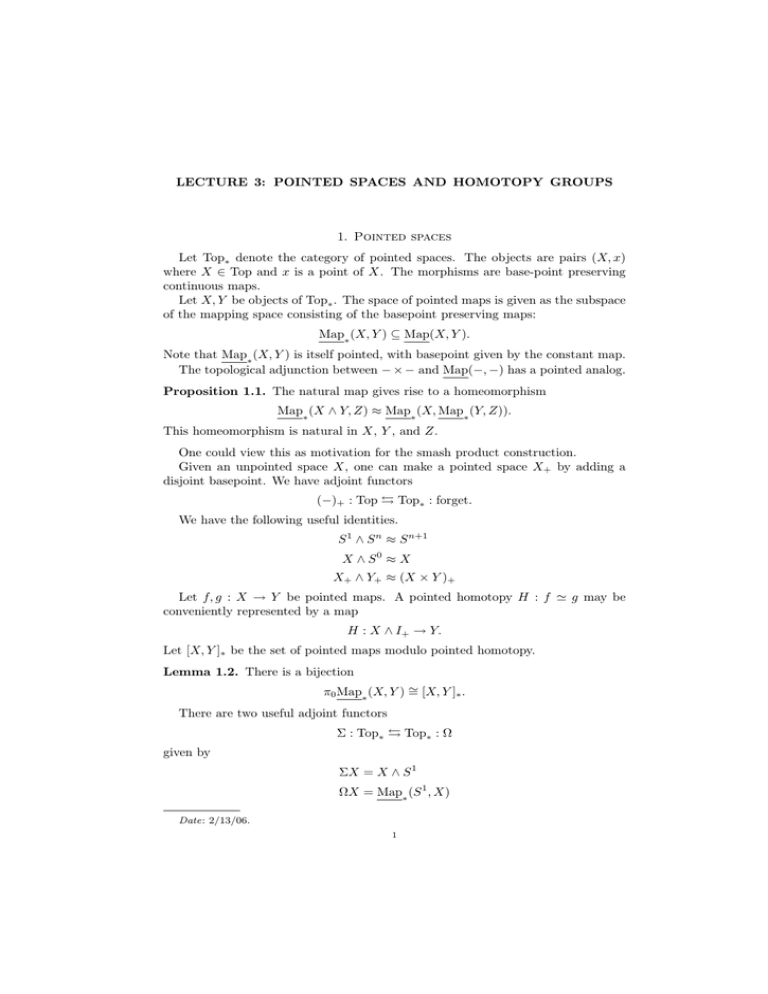
LECTURE 3: POINTED SPACES AND HOMOTOPY GROUPS 1. Pointed spaces Let Top∗ denote the category of pointed spaces. The objects are pairs (X, x) where X ∈ Top and x is a point of X. The morphisms are base­point preserving continuous maps. Let X, Y be objects of Top∗ . The space of pointed maps is given as the subspace of the mapping space consisting of the basepoint preserving maps: Map∗ (X, Y ) ⊆ Map(X, Y ). Note that Map∗ (X, Y ) is itself pointed, with basepoint given by the constant map. The topological adjunction between − × − and Map(−, −) has a pointed analog. Proposition 1.1. The natural map gives rise to a homeomorphism Map∗ (X ∧ Y, Z) ≈ Map∗ (X, Map∗ (Y, Z)). This homeomorphism is natural in X, Y , and Z. One could view this as motivation for the smash product construction. Given an unpointed space X, one can make a pointed space X+ by adding a disjoint basepoint. We have adjoint functors (−)+ : Top � Top∗ : forget. We have the following useful identities. S 1 ∧ S n ≈ S n+1 X ∧ S0 ≈ X X+ ∧ Y+ ≈ (X × Y )+ Let f, g : X → Y be pointed maps. A pointed homotopy H : f � g may be conveniently represented by a map H : X ∧ I+ → Y. Let [X, Y ]∗ be the set of pointed maps modulo pointed homotopy. Lemma 1.2. There is a bijection ∼ [X, Y ]∗ . π0 Map∗ (X, Y ) = There are two useful adjoint functors Σ : Top∗ � Top∗ : Ω given by ΣX = X ∧ S 1 ΩX = Map∗ (S 1 , X) Date: 2/13/06. 1 Note that there are homeomorphisms ΣS n ≈ S n+1 . The disjoint union of unpointed spaces satisfies a universal property: X KK KK f KK KK KK K% f �g X �O Y ∃! s9/ Z s ss sgs s ss ss Y For pointed spaces X, Y , define the wedge to be the union where we have iden­ tified the basepoints X ∨ Y = X ∪∗ Y. The wedge satisfies a similar universal property in the category of pointed spaces. For X, Y, Z ∈ Top∗ we have X KK KK f KK KK KK K% f ∨g X ∨O Y ∃! s9/ Z s ss sgs s ss ss Y 2. Homotopy groups Let X be a pointed space. Define πn (X) = [S n , X] ∗ For n ≥ 1 this is a group. Let pinch : S n → S n ∨ S n be the pinch map (identify all elements on the equator). For α, β : S n → X, define α + β to be the composite pinch α∨β α + β : S n −−−→ S n ∨ S n −−−→ X Lemma 2.1. This binary operation descends to give a group structure on πn (X). Alternatively, addition may be described on maps (I n , ∂I n ) → (X, ∗) by juxta­ position of cubes. See Hatcher or May for this perspective. This perspective gives an easy geometric proof of the following Proposition 2.2. For k > 1, πk (X) is abelian. Given a pointed map f : X → Y , there is an induced map f∗ : πk (X) → πk (Y ) [α] �→ [f ◦ α]. Thus the homotopy groups form a functor πk (−) : Top∗ → Groups. 2
